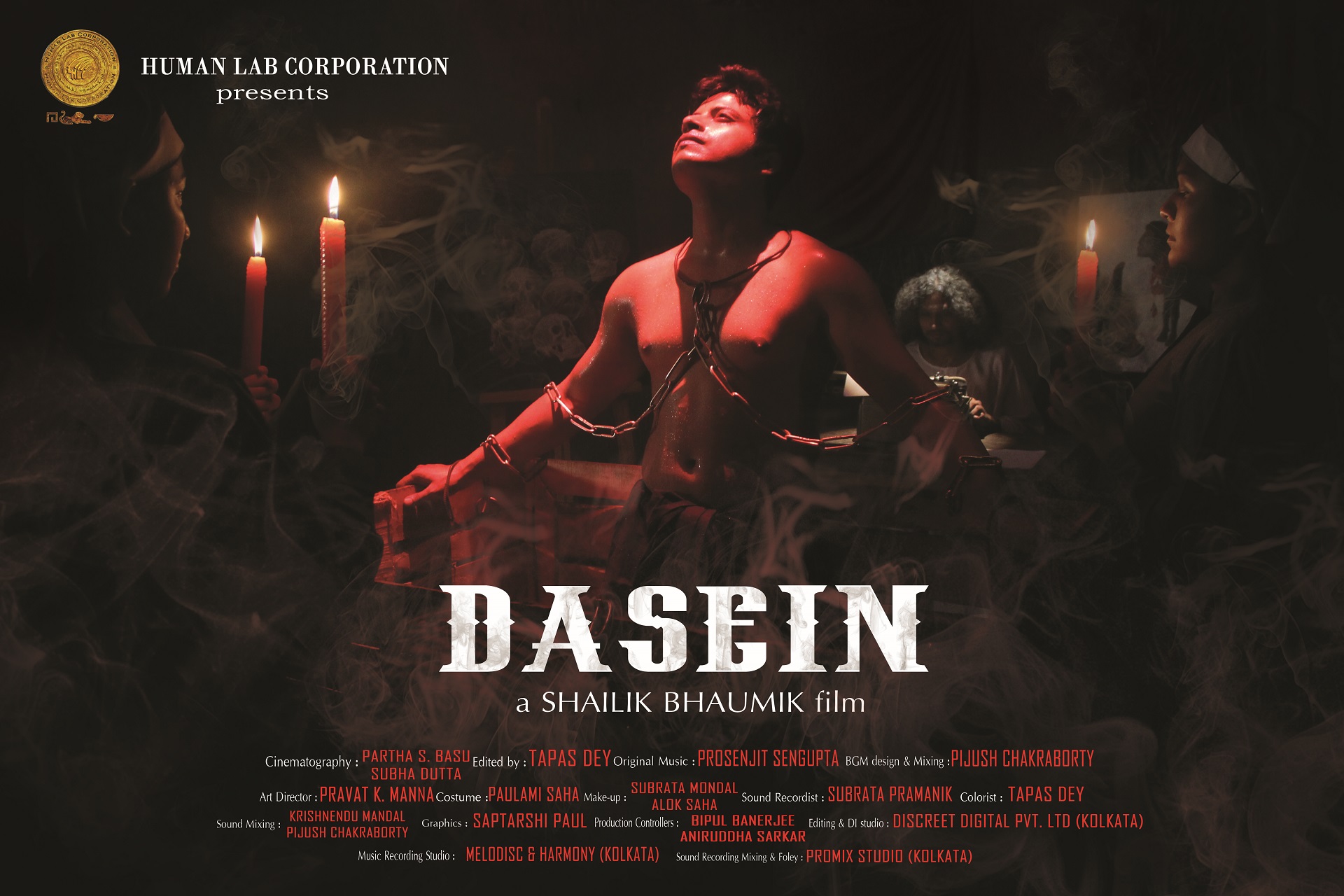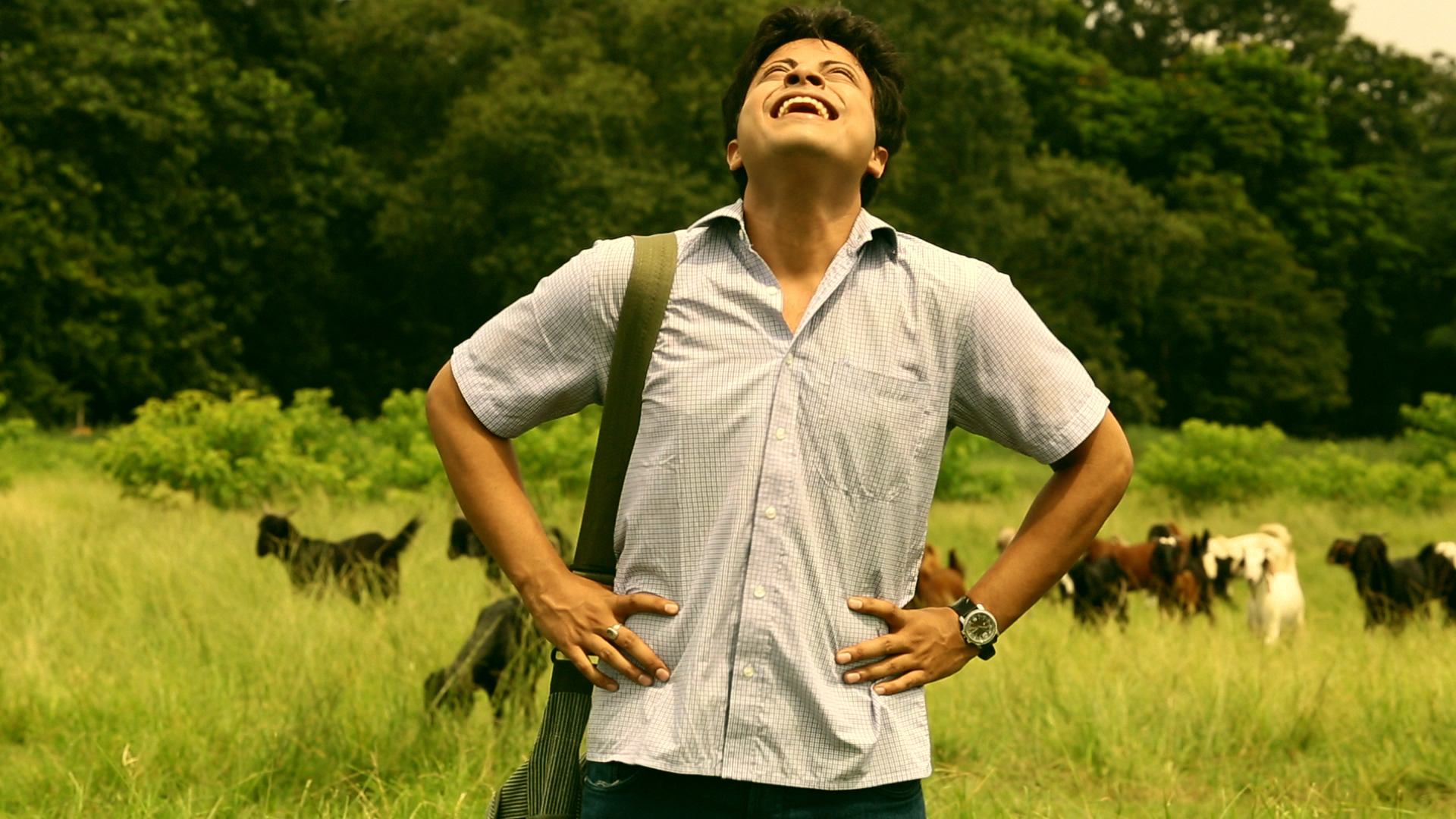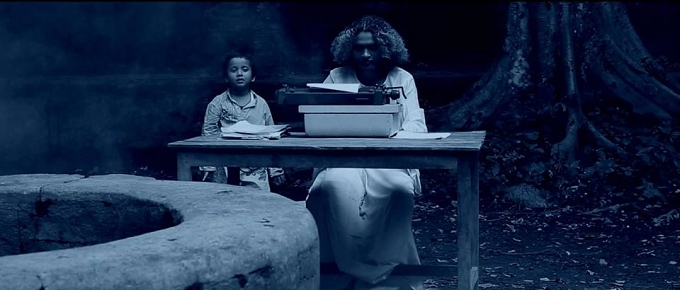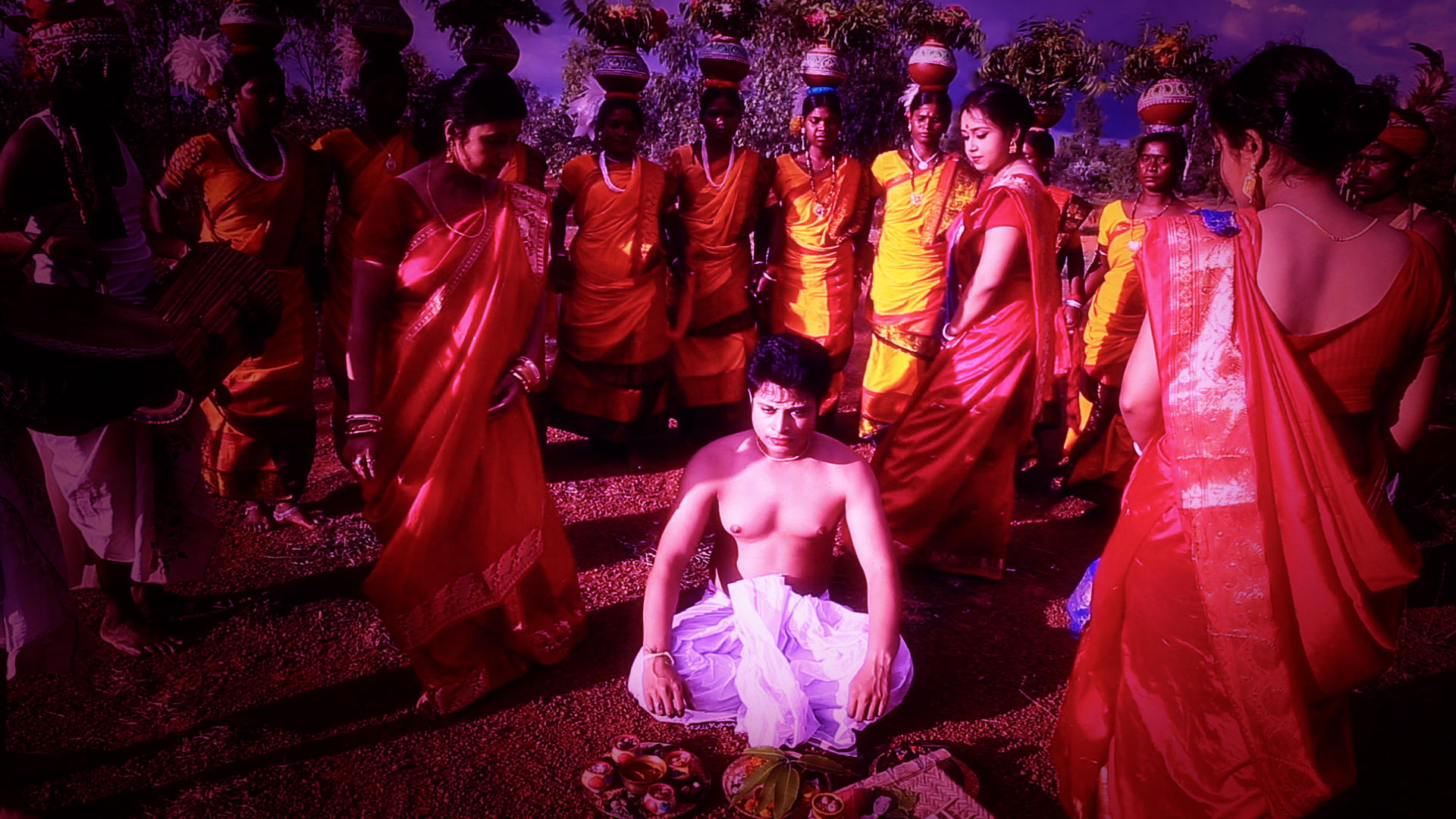Dasein

CAT INDEX
CAT INDEX OVERVIEW
SCREENPLAY
MAKING
ACTING
Directed by Shailik Bhaumik | Reviewed by Sayantan Mukherjee “Dasein is a nonlinear, postmodern, meta-narrative film which explores the core values of existentialism, nihilism, futurism and deconstruction theory.” This is how the filmmaker, Shailik Bhaumik describes his own creation. He posits his creation as an amalgamation of multiple thought experiments and he has used various film forms and techniques to bring it to life. This is indeed the most apt way of describing Dasein to the learned audience. But these are complicated philosophical ideas which are mostly incomprehensible to the non-initiated person. If one is not aware of the intrinsic nature of such ideas, then these would seem like jargon and might inevitably confuse them.  However, there is one line in the film which magically encapsulates the central idea of Dasein quite beautifully. There is a scene in a mental institution, where the protagonist visits his step mother who is admitted there. The doctor informs him that his mother has schizophrenia and a debilitating problem of face blindness – a disease which makes the patient forget the faces of their loved ones. Eventually, the doctor informs, she would also forget her own face. Puzzled by this new information, the protagonist asks the doctor how it could ever be possible to forget your own face. To which, the doctor smiles and replies quite prophetically, “Do we really know who we are?” The entire length of Dasein deals with this central conundrum of identity. The word “Dasein” is German in origin and means “existence” or “the process of being” when translated in English and the film stays true to its title. The film opens with stock shots of certain eminent points in history – showing famous visuals and pictures of war and strife combined with the soundtrack of popular Indian advertisement jingles. It is an unusual combination; however, it points to the contradiction of humanity’s history and legacy – showing a blatant picture of how jarring it seems when juxtaposed together. A commodification of human achievements and suffering. Next, we see a visual of a closed camera that is recording and we can hear a meta-narrator saying that he has been tasked by the filmmaker of Dasein to do a survey of asking random people their reason of existence. In the process of this exposition, the narrator references himself and the film; thus, breaking down the fourth wall from the outset. What the narrator has not realized while spouting his commentary is the fact that the cameraperson has not opened the lens cap of the camera yet. He shouts at the camera person to rectify this immediately and the first visual of Dasein comes to life. We see them approaching a transgender person and asking them about the meaning of life. After we hear their answer, the camera keeps moving through the city, amongst both the squalor and the glamour; asking people from different paths of life the eternal question. Till this point, the film has a very journalistic approach – albeit with an overarching fictional narrative. Along the way, the camera comes across this man named Rahul, who is asked the same question. He is part of a motley crew of friends who are out on a road trip together. We are introduced to the rest of his friends, amongst whom we meet Aniket – the protagonist of the film.
However, there is one line in the film which magically encapsulates the central idea of Dasein quite beautifully. There is a scene in a mental institution, where the protagonist visits his step mother who is admitted there. The doctor informs him that his mother has schizophrenia and a debilitating problem of face blindness – a disease which makes the patient forget the faces of their loved ones. Eventually, the doctor informs, she would also forget her own face. Puzzled by this new information, the protagonist asks the doctor how it could ever be possible to forget your own face. To which, the doctor smiles and replies quite prophetically, “Do we really know who we are?” The entire length of Dasein deals with this central conundrum of identity. The word “Dasein” is German in origin and means “existence” or “the process of being” when translated in English and the film stays true to its title. The film opens with stock shots of certain eminent points in history – showing famous visuals and pictures of war and strife combined with the soundtrack of popular Indian advertisement jingles. It is an unusual combination; however, it points to the contradiction of humanity’s history and legacy – showing a blatant picture of how jarring it seems when juxtaposed together. A commodification of human achievements and suffering. Next, we see a visual of a closed camera that is recording and we can hear a meta-narrator saying that he has been tasked by the filmmaker of Dasein to do a survey of asking random people their reason of existence. In the process of this exposition, the narrator references himself and the film; thus, breaking down the fourth wall from the outset. What the narrator has not realized while spouting his commentary is the fact that the cameraperson has not opened the lens cap of the camera yet. He shouts at the camera person to rectify this immediately and the first visual of Dasein comes to life. We see them approaching a transgender person and asking them about the meaning of life. After we hear their answer, the camera keeps moving through the city, amongst both the squalor and the glamour; asking people from different paths of life the eternal question. Till this point, the film has a very journalistic approach – albeit with an overarching fictional narrative. Along the way, the camera comes across this man named Rahul, who is asked the same question. He is part of a motley crew of friends who are out on a road trip together. We are introduced to the rest of his friends, amongst whom we meet Aniket – the protagonist of the film.  Aniket’s life comes into focus henceforth as the film traverses through the different ages of his life – early childhood, his adolescence, and different portions of his adulthood. Since the film is nonlinear in structure, the narrative jumps from one timeline to another constantly. We see a toddler discovering his hanging mother behind closed doors one day to an adolescent falling in love in college to an adult trying to deal with his young step mother, for whom he later develops sexual feelings.
Aniket’s life comes into focus henceforth as the film traverses through the different ages of his life – early childhood, his adolescence, and different portions of his adulthood. Since the film is nonlinear in structure, the narrative jumps from one timeline to another constantly. We see a toddler discovering his hanging mother behind closed doors one day to an adolescent falling in love in college to an adult trying to deal with his young step mother, for whom he later develops sexual feelings.  It is a pathetic life where Aniket has seen death from the very start. His father is never in picture and he spends most of his time with his mother. Aniket is a happy child, playing around underneath a tiger mask which he wears to pretend-scare his mother. His mother is an unhappy woman, which is seen much later as a very young Aniket stumbles upon her hanging body in her room. Aniket is thrust into adulthood instantly; his childlike demeanor snatched from him in a moment of disbelief. We see a young adult Aniket being praised for his paintings in art college and a young woman approaching him; apparently impressed by his art. They have long conversations about love, life, and death; and Aniket feels that this woman might be special. His left-over innocence leads him to tell her about his plan of entering a government sponsored competition with his artwork “Dasein,” which he has designed to portray his philosophy of life. He is not looking to earn money from art, he professes to the woman, but rather requires a platform to showcase his thought process. In a few months, he finds out that the woman he was speaking to has been featured on the national newspaper for her entry “Dasein” in the same competition. Aniket goes to an empty space and laughs his heart out. A melancholic raga plays in the background, accompanying Aniket’s exasperated laughter; creating a symphony of chaos and turmoil rolling into one.
It is a pathetic life where Aniket has seen death from the very start. His father is never in picture and he spends most of his time with his mother. Aniket is a happy child, playing around underneath a tiger mask which he wears to pretend-scare his mother. His mother is an unhappy woman, which is seen much later as a very young Aniket stumbles upon her hanging body in her room. Aniket is thrust into adulthood instantly; his childlike demeanor snatched from him in a moment of disbelief. We see a young adult Aniket being praised for his paintings in art college and a young woman approaching him; apparently impressed by his art. They have long conversations about love, life, and death; and Aniket feels that this woman might be special. His left-over innocence leads him to tell her about his plan of entering a government sponsored competition with his artwork “Dasein,” which he has designed to portray his philosophy of life. He is not looking to earn money from art, he professes to the woman, but rather requires a platform to showcase his thought process. In a few months, he finds out that the woman he was speaking to has been featured on the national newspaper for her entry “Dasein” in the same competition. Aniket goes to an empty space and laughs his heart out. A melancholic raga plays in the background, accompanying Aniket’s exasperated laughter; creating a symphony of chaos and turmoil rolling into one.  Aniket goes from temples to churches to mosques – trying to figure out what it all really means; whether there is any meaning to life at all. The religious scriptures and teachings have always been untrue in his life. He is fighting to believe that “fate” doesn’t exist – and instead, it is the choices we make in life, that defines who we are. He has decided that he would die on his own terms; uninfluenced by outer stimuli. But fate does not stop because of someone’s personal belief. Much like Bergman’s “Seventh Seal,” we see fate/death personified here as an old person sitting in a chair inside an abandoned decrepit structure. A young version of Aniket plays around in front of him, unaware of the fate that is being prepared for him right there. Fate types a statement of finality on a piece of paper which states – “Aniket Chatterjee will die on 1st August, 2014 at 9:30 pm. He will commit suicide by taking sleeping pills.”
Aniket goes from temples to churches to mosques – trying to figure out what it all really means; whether there is any meaning to life at all. The religious scriptures and teachings have always been untrue in his life. He is fighting to believe that “fate” doesn’t exist – and instead, it is the choices we make in life, that defines who we are. He has decided that he would die on his own terms; uninfluenced by outer stimuli. But fate does not stop because of someone’s personal belief. Much like Bergman’s “Seventh Seal,” we see fate/death personified here as an old person sitting in a chair inside an abandoned decrepit structure. A young version of Aniket plays around in front of him, unaware of the fate that is being prepared for him right there. Fate types a statement of finality on a piece of paper which states – “Aniket Chatterjee will die on 1st August, 2014 at 9:30 pm. He will commit suicide by taking sleeping pills.”  The film does not pay heed to multiple ways of being and instead chooses to show that the future is deterministic; beyond any scope of change. Women play an important role in Aniket’s life – from start to end. He loses his one companion - his mother, at a very young age. He then goes on to lose the love of his life to another man, his ideas to a woman he thought loved him and finally, he devolves into insanity when a step mother comes into his life and falls in love with him; ultimately making her pregnant and then choosing to abort it. The symbolic sequence of three women – his birth mother, his love and his step mother praying to him and rubbing turmeric on his face - is the best representation of his life in totality.
The film does not pay heed to multiple ways of being and instead chooses to show that the future is deterministic; beyond any scope of change. Women play an important role in Aniket’s life – from start to end. He loses his one companion - his mother, at a very young age. He then goes on to lose the love of his life to another man, his ideas to a woman he thought loved him and finally, he devolves into insanity when a step mother comes into his life and falls in love with him; ultimately making her pregnant and then choosing to abort it. The symbolic sequence of three women – his birth mother, his love and his step mother praying to him and rubbing turmeric on his face - is the best representation of his life in totality.  Multiple forms of storytelling techniques have been used here to show Aniket’s story. The overtly dramatized and eerie visuals of death writing Aniket’s fate is very different from Aniket’s road trip with his friends. Using stock shots, hand held camera movements, directly addressing the audience, use of surrealistic sequences to show Aniket’s mind, rampant symbolism and abstraction runs amok through the film; making the audience go through a plethora of emotions in its 2-hour 22-minute runtime.
Multiple forms of storytelling techniques have been used here to show Aniket’s story. The overtly dramatized and eerie visuals of death writing Aniket’s fate is very different from Aniket’s road trip with his friends. Using stock shots, hand held camera movements, directly addressing the audience, use of surrealistic sequences to show Aniket’s mind, rampant symbolism and abstraction runs amok through the film; making the audience go through a plethora of emotions in its 2-hour 22-minute runtime.  I would consider this film to be best watched as a psychedelic experience. The heady themes and ideas that run crazy on Aniket’s mind as he confesses that he is slowly losing control over life is a mind-bending experience. We are taken on a journey of absurdity, comedy and tragedy throughout the film’s runtime which can make one ask themselves the eternal questions. Hence, it is quite apt that the director, Shailik Bhaumik warns his viewers from the trailer itself – Watch it at your own risk! Everyone should watch it, as risk is one of the most prominent ways in which we can feel ourselves alive and present, inhabiting a body of flesh and blood – that can be snatched away from us at any moment. Let us be honest with ourselves, what is art or life, if not lived or experienced at its very best? Dasein can prove to be the best way to start.
I would consider this film to be best watched as a psychedelic experience. The heady themes and ideas that run crazy on Aniket’s mind as he confesses that he is slowly losing control over life is a mind-bending experience. We are taken on a journey of absurdity, comedy and tragedy throughout the film’s runtime which can make one ask themselves the eternal questions. Hence, it is quite apt that the director, Shailik Bhaumik warns his viewers from the trailer itself – Watch it at your own risk! Everyone should watch it, as risk is one of the most prominent ways in which we can feel ourselves alive and present, inhabiting a body of flesh and blood – that can be snatched away from us at any moment. Let us be honest with ourselves, what is art or life, if not lived or experienced at its very best? Dasein can prove to be the best way to start.
 Sayantan Mukherjee is a teacher, writer and professional video editor based in Kolkata, India. He serves as the Chief-Editor of Cult Critic Film Magazine. He teaches at Lakshmipat Singhania Academy and as Visiting Faculty in Aliah University. He also works for EMMRC, St. Xavier’s College as anchor and editor of numerous MOOC programmes made for UGC, India.
Sayantan Mukherjee is a teacher, writer and professional video editor based in Kolkata, India. He serves as the Chief-Editor of Cult Critic Film Magazine. He teaches at Lakshmipat Singhania Academy and as Visiting Faculty in Aliah University. He also works for EMMRC, St. Xavier’s College as anchor and editor of numerous MOOC programmes made for UGC, India.


